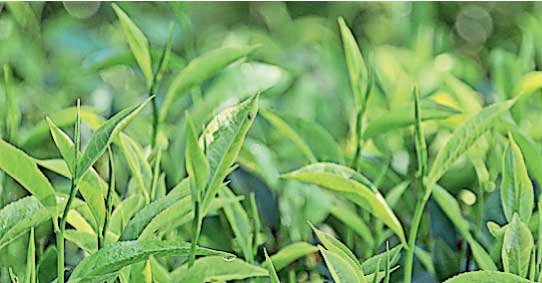Saturday Dec 13, 2025
Saturday Dec 13, 2025
Friday, 28 October 2016 00:01 - - {{hitsCtrl.values.hits}}
 Cumulative tea exports up to September 2016 from the start of the year including re-exports amounted to 222.76 Mn/Kg, showing a marginal decline of 1.48% to 3.34 Mn/kg compared to the same period last year but cumulative export earnings amounted to Rs. 137.59 billion, showing a slight gain of 2.11% or Rs. 2.84 billion against the corresponding period of the previous year.
Cumulative tea exports up to September 2016 from the start of the year including re-exports amounted to 222.76 Mn/Kg, showing a marginal decline of 1.48% to 3.34 Mn/kg compared to the same period last year but cumulative export earnings amounted to Rs. 137.59 billion, showing a slight gain of 2.11% or Rs. 2.84 billion against the corresponding period of the previous year.
The main reason for the gain was the increase in FOB price per kg from Rs. 595.95 to Rs. 617.66, tea brokers said in their monthly reports according to Ceylon Tea Brokers.
September tea exports, including re-export which amounted to 25.43 Mn/kg, showing a marginal increase of 0.81 Mn/kg or 3.28% growth when compared to the same period last year and adding to the relief total export earnings, showed promise, gaining 13.41% to Rs. 1.98 billion against the corresponding period of the previous year.
A country analysis of exports shows that Iraq remains the largest importer of Sri Lanka tea from January-September 2016, followed by Russia and Iran.
However, auction quantities declined further to 4.6 M/kg this week against the backdrop of limited availability and the tea market continued to be buoyant, Forbes and Walker said in its report.
Ex-Estate catalogues totalled a small volume of 0.6M/kg and is the lowest quantity on offer at a given sale in over a decade. Consequent to the limited availability, the overall quality of the teas on offer was of a useful standard for the time of year, it added.
With Best Western’s, the majority of the teas declined by Rs. 10-20 per kg while the corresponding BOPFs were irregular. BOPs in the below best category were irregular while plainer sorts sold around last week’s levels.
Corresponding BOPFs too were mostly firm. Nuwara Eliya’s best available teas were mostly unsold while the others were sold around last week’s levels.
Corresponding BOPFs gained Rs. 10-20 per kg. Once again, the disappointing feature continues to be the lack of differentiation in prices between the better teas and their counterparts. Yet another concern would be the overall price structure for Nuwara Eliya teas which in comparison to other High and Medium Grown small leaf teas compare very poorly on price.
Udapussellawa BOPs were mostly firm while the corresponding BOPFs declined Rs. 10-Rs. 20 per kg. With Uva BOP/BOPFs, the majority declined Rs. 10-Rs. 20 per kg. High and Medium Grown CTC BP1s were firm and tended dearer while the PF1s were often Rs. 10 per kg lower. Corresponding Low Grown varieties and BP1s followed a similar trend while the PF1s were Rs. 10-20 per kg more expensive, particularly teas in the higher price range.
There was fair demand from shippers to CIS, China, Hong Kong and Japan while the UK and the continent continued to be fairly selective, the report observed.
Low Growns totalled 2.4 M/kg in the Leafy/Tippy catalogues. There was good demand. In the Leafy catalogue OP1s together with OP gained Rs.10-20 per kg and more particularly for the improved below best sorts.
OPAs were firm to dearer while PEK/PEK1s too were fully firm to dearer barring a few below best types which were barely steady.
BOP1s, though irregular, were firm. In the Tippy catalogue too FBOPs gained Rs. 10-20 per kg while FF1s were fully firm to dearer. However, teas at the lower end were irregular, particularly where quality was not maintained. In the Premium catalogue too prices were fully firm to selectively dearer. Shippers to CIS, Dubai, Saudi Arabia, Kuwait and Iraq were active this week.